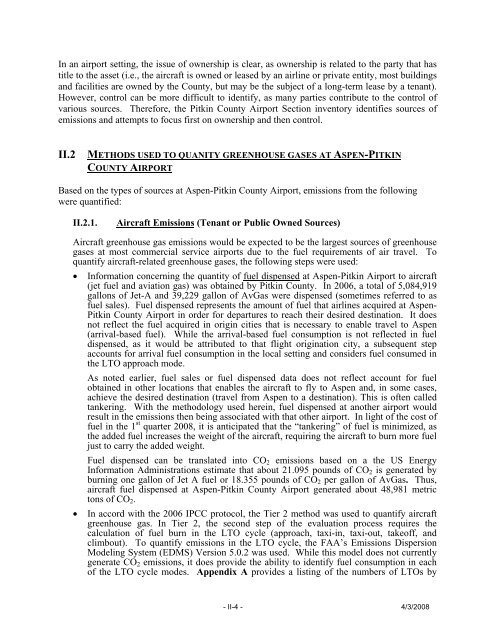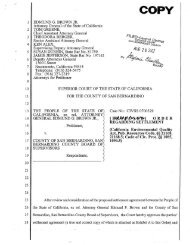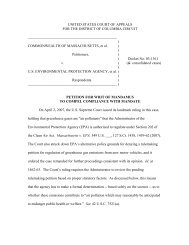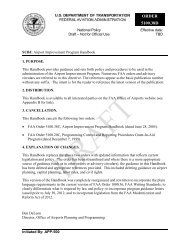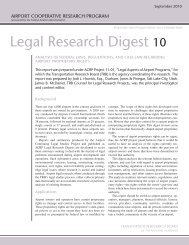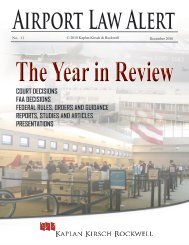Aspen-Pitkin County Airport Greenhouse Gas Emissions Inventory ...
Aspen-Pitkin County Airport Greenhouse Gas Emissions Inventory ...
Aspen-Pitkin County Airport Greenhouse Gas Emissions Inventory ...
You also want an ePaper? Increase the reach of your titles
YUMPU automatically turns print PDFs into web optimized ePapers that Google loves.
In an airport setting, the issue of ownership is clear, as ownership is related to the party that hastitle to the asset (i.e., the aircraft is owned or leased by an airline or private entity, most buildingsand facilities are owned by the <strong>County</strong>, but may be the subject of a long-term lease by a tenant).However, control can be more difficult to identify, as many parties contribute to the control ofvarious sources. Therefore, the <strong>Pitkin</strong> <strong>County</strong> <strong>Airport</strong> Section inventory identifies sources ofemissions and attempts to focus first on ownership and then control.II.2METHODS USED TO QUANITY GREENHOUSE GASES AT ASPEN-PITKINCOUNTY AIRPORTBased on the types of sources at <strong>Aspen</strong>-<strong>Pitkin</strong> <strong>County</strong> <strong>Airport</strong>, emissions from the followingwere quantified:II.2.1.Aircraft <strong>Emissions</strong> (Tenant or Public Owned Sources)Aircraft greenhouse gas emissions would be expected to be the largest sources of greenhousegases at most commercial service airports due to the fuel requirements of air travel. Toquantify aircraft-related greenhouse gases, the following steps were used:• Information concerning the quantity of fuel dispensed at <strong>Aspen</strong>-<strong>Pitkin</strong> <strong>Airport</strong> to aircraft(jet fuel and aviation gas) was obtained by <strong>Pitkin</strong> <strong>County</strong>. In 2006, a total of 5,084,919gallons of Jet-A and 39,229 gallon of Av<strong>Gas</strong> were dispensed (sometimes referred to asfuel sales). Fuel dispensed represents the amount of fuel that airlines acquired at <strong>Aspen</strong>-<strong>Pitkin</strong> <strong>County</strong> <strong>Airport</strong> in order for departures to reach their desired destination. It doesnot reflect the fuel acquired in origin cities that is necessary to enable travel to <strong>Aspen</strong>(arrival-based fuel). While the arrival-based fuel consumption is not reflected in fueldispensed, as it would be attributed to that flight origination city, a subsequent stepaccounts for arrival fuel consumption in the local setting and considers fuel consumed inthe LTO approach mode.As noted earlier, fuel sales or fuel dispensed data does not reflect account for fuelobtained in other locations that enables the aircraft to fly to <strong>Aspen</strong> and, in some cases,achieve the desired destination (travel from <strong>Aspen</strong> to a destination). This is often calledtankering. With the methodology used herein, fuel dispensed at another airport wouldresult in the emissions then being associated with that other airport. In light of the cost offuel in the 1 st quarter 2008, it is anticipated that the “tankering” of fuel is minimized, asthe added fuel increases the weight of the aircraft, requiring the aircraft to burn more fueljust to carry the added weight.Fuel dispensed can be translated into CO 2 emissions based on a the US EnergyInformation Administrations estimate that about 21.095 pounds of CO 2 is generated byburning one gallon of Jet A fuel or 18.355 pounds of CO 2 per gallon of Av<strong>Gas</strong>. Thus,aircraft fuel dispensed at <strong>Aspen</strong>-<strong>Pitkin</strong> <strong>County</strong> <strong>Airport</strong> generated about 48,981 metrictons of CO 2 .• In accord with the 2006 IPCC protocol, the Tier 2 method was used to quantify aircraftgreenhouse gas. In Tier 2, the second step of the evaluation process requires thecalculation of fuel burn in the LTO cycle (approach, taxi-in, taxi-out, takeoff, andclimbout). To quantify emissions in the LTO cycle, the FAA’s <strong>Emissions</strong> DispersionModeling System (EDMS) Version 5.0.2 was used. While this model does not currentlygenerate CO 2 emissions, it does provide the ability to identify fuel consumption in eachof the LTO cycle modes. Appendix A provides a listing of the numbers of LTOs by- II-4 - 4/3/2008


